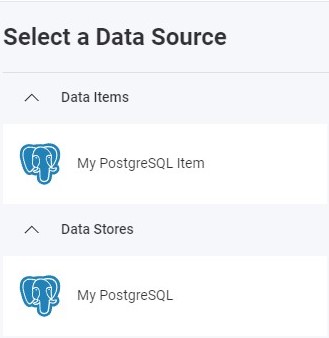PostgreSQL データ ソースの追加
現在、Reveal SDK は、Reveal SDK core パッケージからデータ ソースを分離する過程にあります。プロジェクトの継続的な機能を確保するために、プロジェクトに追加のパッケージをインストールすることが必要になる場合があります。詳細については、サポートされるデータ ソース トピックを参照してください。
クライアント側
手順 1 - RevealView.onDataSourcesRequested イベントのイベント ハンドラーを追加します。
var revealView = new $.ig.RevealView("#revealView");
revealView.onDataSourcesRequested = (callback) => {
//add code here
callback(new $.ig.RevealDataSources([], [], false));
};
手順 2 - RevealView.onDataSourcesRequested イベント ハンドラーで、RVPostgresDataSource オブジェクトの新しいインスタンスを作成します。Host、Database、Port、および Title プロパティを、PostgreSQL サーバーに対応する値に設定します。RVPostgresDataSource オブジェクトを作成したら、それをデータ ソース コレクションに追加します。
revealView.onDataSourcesRequested = (callback) => {
var postgresDataSource = new $.ig.RVPostgresDataSource();
postgresDataSource.host = "your-db-host";
postgresDataSource.database = "your-db-name";
postgresDataSource.port = 1234;
postgresDataSource.title = "My PostgreSQL";
callback(new $.ig.RevealDataSources([postgresDataSource], [], false));
};
アプリケーションが実行されたら、新しい可視化を作成すると、新しく作成された PostgreSQL データ ソースが [データ ソースの選択] ダイアログに表示されます。
手順 3 - RVPostgresDataSourceItem オブジェクトの新しいインスタンスを作成して、新しいデータ ソース項目を追加します。データベース テーブルに対応する Id、Title、および Table プロパティを設定します。RVPostgresDataSourceItem オブジェクトを作成したら、それをデータ ソース項目コレクションに追加します。
revealView.onDataSourcesRequested = (callback) => {
var postgresDataSource = new $.ig.RVPostgresDataSource();
postgresDataSource.host = "your-db-host";
postgresDataSource.database = "your-db-name";
postgresDataSource.port = 1234;
postgresDataSource.title = "My PostgreSQL";
var postgresDsi = new $.ig.RVPostgresDataSourceItem(postgresDataSource);
postgresDsi.id = "MyPostgresDataSourceItem";
postgresDsi.title = "My PostgreSQL Item";
postgresDsi.table = "TableName";
callback(new $.ig.RevealDataSources([postgresDataSource], [postgresDsi], false));
};
アプリケーションが実行されたら、新しい可視化を作成すると、新しく作成された PostgreSQL データ ソース項目が [データ ソースの選択] ダイアログに表示されます。

サーバー側
手順 1 - クライアントでデータ ソースとデータ ソース項目を作成しますが、接続情報は指定しません。id、title、および/または subtitle のみを入力してください。
var revealView = new $.ig.RevealView("#revealView");
revealView.onDataSourcesRequested = (callback) => {
var postgresDataSource = new $.ig.RVPostgresDataSource();
postgresDataSource.id = "MyPostgresDataSource";
postgresDataSource.title = "My PostgreSQL";
var postgresDsi = new $.ig.RVPostgresDataSourceItem(postgresDataSource);
postgresDsi.id = "MyPostgresDataSourceItem";
postgresDsi.title = "My PostgreSQL Item";
callback(new $.ig.RevealDataSources([postgresDataSource], [postgresDsi], false));
};
手順 2 - データ ソース プロバイダーを作成します。この例では、クライアントで定義された PostgreSQL データベースに接続するための接続情報を提供しています。これを実現するために、使用しているデータ ソース/項目のタイプを決定し、オブジェクトで使用可能なプロパティを設定します。
- ASP.NET
- Java
- Node.js
- Node.js - TS
public class DataSourceProvider : IRVDataSourceProvider
{
public Task<RVDataSourceItem> ChangeDataSourceItemAsync(IRVUserContext userContext, string dashboardId,
RVDataSourceItem dataSourceItem)
{
if (dataSourceItem is RVPostgresDataSourceItem postgresDataSourceItem)
{
//update underlying data source
ChangeDataSourceAsync(userContext, postgresDataSourceItem.DataSource);
//only change the table if we have selected our custom data source item
if (postgresDataSourceItem.Id == "MyPostgresDataSourceItem")
{
postgresDataSourceItem.Table = "orders";
}
}
return Task.FromResult(dataSourceItem);
}
public Task<RVDashboardDataSource> ChangeDataSourceAsync(IRVUserContext userContext,
RVDashboardDataSource dataSource)
{
if (dataSource is RVPostgresDataSource postgresDataSource)
{
postgresDataSource.Host = "localhost";
postgresDataSource.Database = "database";
postgresDataSource.Schema = "public";
}
return Task.FromResult(dataSource);
}
}
public class DataSourceProvider implements IRVDataSourceProvider {
public RVDataSourceItem changeDataSourceItem(IRVUserContext userContext, String dashboardsID, RVDataSourceItem dataSourceItem) {
if (dataSourceItem instanceof RVPostgresDataSourceItem postgresDataSourceItem) {
//update underlying data source
changeDataSource(userContext, dataSourceItem.getDataSource());
//only change the table if we have selected our custom data source item
if (dataSourceItem.getId() == "MyPostgresDataSourceItem") {
postgresDataSourceItem.setTable("orders");
}
}
return dataSourceItem;
}
public RVDashboardDataSource changeDataSource(IRVUserContext userContext, RVDashboardDataSource dataSource) {
if (dataSource instanceof RVPostgresDataSource postgresDataSource) {
postgresDataSource.setHost("localhost");
postgresDataSource.setDatabase("database");
postgresDataSource.setSchema("public");
}
return dataSource;
}
}
const dataSourceItemProvider = async (userContext, dataSourceItem) => {
if (dataSourceItem instanceof reveal.RVPostgresDataSourceItem) {
//update underlying data source
dataSourceProvider(userContext, dataSourceItem.dataSource);
//only change the table if we have selected our data source item
if (dataSourceItem.id === "MyPostgresDataSourceItem") {
dataSourceItem.table = "orders";
}
}
return dataSourceItem;
}
const dataSourceProvider = async (userContext, dataSource) => {
if (dataSource instanceof reveal.RVPostgresDataSource) {
dataSource.host = "localhost";
dataSource.database = "database";
dataSource.schema = "public";
}
return dataSource;
}
const dataSourceItemProvider = async (userContext: IRVUserContext | null, dataSourceItem: RVDataSourceItem) => {
if (dataSourceItem instanceof RVPostgresDataSourceItem) {
//update underlying data source
dataSourceProvider(userContext, dataSourceItem.dataSource);
//only change the table if we have selected our data source item
if (dataSourceItem.id === "MyPostgresDataSourceItem") {
dataSourceItem.table = "orders";
}
}
return dataSourceItem;
}
const dataSourceProvider = async (userContext: IRVUserContext | null, dataSource: RVDashboardDataSource) => {
if (dataSource instanceof RVPostgresDataSource) {
dataSource.host = "localhost";
dataSource.database = "database";
dataSource.schema = "public";
}
return dataSource;
}
このサンプルのソース コードは GitHub にあります。